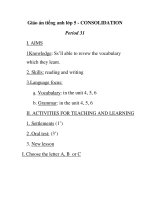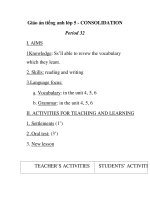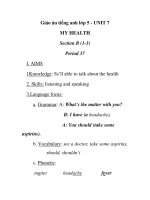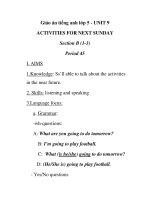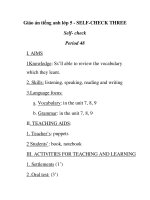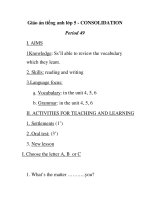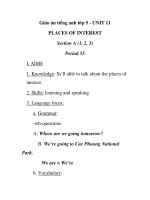giao an tieng anh lop 5 hk2
Bạn đang xem bản rút gọn của tài liệu. Xem và tải ngay bản đầy đủ của tài liệu tại đây (269.42 KB, 75 trang )
Week 19
Date of planing : 2/ 9/ 2016
Period 37
Date of teaching: 5- 6 /9/2016.
Unit 11: WHAT’S THE MATTER WITH YOU?
Lesson 1: Part 1-2-3
I. Objectives: By the end of this unit pupils can
- Use the words and phrases related to the topics Common health problems. Ask
and answer questions about Common health problems, using What’s the matter
with you? I have ...
- Develop Ss speaking and listening skills.
- Ss look after , solve problems and study themselves.
- Studious and obedient students and love their hometown, family and friends.
II. Languages focus:
- Sentence Pattners: What’s the matter with you? I have ...
- Vocabulary: toothache, earache, sore throat, stomach ache, dentist, fever, ... .
III. Teaching aids:
1. Teacher’s: student’s and teacher’s book, pictures, cassette.
2. Students’: books, notebooks, workbooks.
IV. Teaching processes:
1. Class organization:
- Greeting. Checking for the students' attendance.
2. New lesson
Teacher’s activities
Students’ activities
Warm up: Play slap the - The class play: using the pictures and names of
board
characters that they have learnt in unit 1-10.
1. Look, listen and repeat.
- Introduce the dialogue.
- Look at the pictures in the book, identify the
characters in the picture on page 6 and what they
are saying.
- Listen to Tony and mother’s Tony.
- Play the recording
- Check and corect.
- Ss listen and repeat in chorus two times.
- Read in group/ pair: One repeats Tony’s part, the
other repeats mother’s part of Tony.
- Ss give new structure sentence:
- Elicits the structure
- What’s the matter with you? I have ...
- Note write down new words and read after T.
2. Point and say
Play game: What and where ( Whole class)
- Teach vocabulary:
Check vocab: what & where - Pupils guess and complete the speech bubbles.
- Model sentence.
- Look and find out the model sentences
- Monitor the activity and - Point the pictures and practise asking and
answering question about one’s address.
offer help, if necessary.
- Check and correct.
- 2 - 3 pairs perform their task at the front of the
class. The rest of the class observe and give
comments.
3. Let’s Talk
- Ss work in pairs to practise asking and answering
question about one’s address.
- Give tasks.
- Practise in pairs
- 6-7 pairs perform their task at the front of the
class. The rest of the class observe and give
comments.
- Correct their
pronunciation and mistake.
4.Consolidation
- Do exercises in workbook, learn by heart the
new words.
Summary the lesson
5.Homework
Week 19
Date of planing : 2/ 9/ 2016
Period 38
Date of teaching: 6 - 7/9/2016.
Unit 11: WHAT’S THE MATTER WITH YOU?
Lesson 2: Part 1-2-3
I. Objectives: By the end of this unit pupils can
- Use the words and phrases related to the topics Common health problems. Give
and respond to advivce to common health problems, using You should/shouldn’t ...
Yes, I will./OK, I won’t.
- Develop Ss speaking and listening skills.
- Ss look after , solve problems and study themselves.
- Studious and obedient students and love their hometown, family and friends.
II. Languages focus:
- Sentence Pattners: You should/shouldn’t ... Yes, I will./OK, I won’t.
- Vocabulary: dentist, take a rest, carry, sweet...
III. Teaching aids:
1. Teacher’s: student’s and teacher’s book, pictures, cassette.
2. Students’: books, notebooks, workbooks.
IV. Teaching processes:
1. Class organization:
- Greeting. Checking for the students' attendance.
2. New lesson
Teacher’s activities
Students’ activities
Warm up: Sing - What’s the - The class sing: What’s the matter with you?
matter with you? Song.
1. Look, listen and repeat.
- Introduce the dialogue.
- Play the recording
- Look at the pictures in the book guess what the
story is about and point at each picture to elicit
their answers to these questions .
- Listen follow in their book.
- Ss listen and repeat in chorus two times.
- Check and corect.
- Read in group/ pair: One repeats Mai’s part, the
other repeats Nam’s part and Quan’s part.
- Ss give new structure sentence:
- Elicits the structure
2. Point and say
- You should/shouldn’t ... Yes, I will./OK, I won’t.
- Note write down new words and read after T.
- Teach vocabulary: dentist,
Play game: What and where ( Whole class)
take a rest, carry...
Check vocab: what &
where
- Look and find out the model sentences
- Point the pictures and practise asking and
- Model sentence.
answering question You should/shouldn’t ... Yes, I
will./OK, I won’t.
- Monitor the activity and
offer help, if necessary.
- 2 - 3 pairs perform their task at the front of the
class. The rest of the class observe and give
comments.
- Check and correct.
- Ss work in pairs to practise asking and answering
questions about where they live.
3. Let’s Talk
- Give tasks.
- Pupils practise answer ing the questions with
information about themselves.
- 6-7 pairs perform their task at the front of the
- Monitor the activity and class. The rest of the class observe and give
offer help, if necessary.
comments.
- Correct their
pronunciation and mistake.
4.Consolidation
Summary the lesson
5.Homework
- Do exercises in workbook, learn by heart the
new words.
Week 20
Date of planing : 2/ 9/ 2016
Period 39
Date of teaching: 12-13 /9/2016.
Unit 11: WHAT’S THE MATTER WITH YOU?
Lesson 3: Part 1-2-3
I. Objectives: By the end of this unit pupils can
- Say questions and answers with the correct intonation.
- Develop Ss speaking and listening skills.
- Ss look after , solve problems and study themselves.
- Studious and obedient students and love their hometown, family and friends.
II. Languages focus:
- Phonetic: What’s the matter with you?
I have a headache.
III. Teaching aids:
1. Teacher’s: student’s and teacher’s book, pictures, cassette.
2. Students’: books, notebooks, workbooks.
IV. Teaching processes:
1. Class organization:
- Greeting. Checking for the students' attendance.
2. New lesson
Teacher’s activities
Students’ activities
Warm up: Play bingo game
- The class play: bingo game with toothache,
earache, sore throat, stomach ache, dentist,
fever.... Finally, pupils make sentences with the
words used in the game.
1. Look, listen and repeat.
- Look at the sentences to say questions and
answers with the correct intonation.
- Introduce sentences with
how to practise saying
questions and answers with
the correct intonation.
- Guide Ss produce the
others.
- Listen follow in their book.
- Ss learn to say questions and answers with the
correct intonation.
- Listen the CD and repeat the words & sentences
in chorus.
- Read in groups/ in pairs.
- Give out and check.
- Check and corect.
2. Listen and circle a or b.
- Read the sentences in silence before listening the
Then ask and answer.
recording to do the task.
- Give tasks.
- Guide Ss to listen & circle.
- Compare the answers each other before checking
as a class.
- Play the recording.
- 3- 4 pupils give the keys. The rest of the class
observe and give comments.
- Check and correct.
1.b
2.b
3. Let’s chant
3. a
- Pupils listen the recording 2 times and circle a or
b to complete sentences.
4. a
- Ps listen to the tape & read the chant line by line.
- Ps practise chanting: one chants the questions
- Introduce the Chant :
and the other chants the answers.
What’s the matter with you?
- Ps practise chanting and doing actions.
- 2-3 groups to say the chant and do actions.
-Teacher reinforce their
pronunciation
Summary the lesson
- Ss to do exercises in C, D (WB) .
4.Consolidation
5.Homework
Week 20
Date of planing : 10/ 9/ 2016
Period 40
Date of teaching: 13-14 /9/2016.
Unit 12: DON’T RIDE YOUR BIKE TOO FAST!
Lesson 1: Part 1-2-3
I. Objectives: By the end of this unit pupils can
- Use the words and phrases related to the topic Preventing accidents at home.
Express and repond to concerns about possible accident at home, using Don’t ...!
OK, I won’t.
- Develop Ss speaking and listening skills.
- Ss look after , solve problems and study themselves.
- Studious and obedient students and love their hometown, family and friends.
II. Languages focus:
- Sentence Pattners: Don’t ...! OK, I won’t.
- Vocabulary: knife, matches, stair, stove, arm, leg, clim, run, down, fall off....
III. Teaching aids:
1. Teacher’s: student’s and teacher’s book, pictures, cassette.
2. Students’: books, notebooks, workbooks.
IV. Teaching processes:
1. Class organization:
- Greeting. Checking for the students' attendance.
2. New lesson
Teacher’s activities
Students’ activities
Warm up:
chant: What’s the matter
with you?
1. Look, listen and repeat.
- Introduce the dialogue.
- The class chant.
- Look at the pictures in the book, identify the
characters in the picture on page 12 and what they
are saying.
- Listen to Mary and Tom on the tape.
- Play the recording
- Ss listen and repeat line by line in chorus twice.
- Read in group/ pair: One repeats Mary’s part, the
other repeats Tom’s part.
- Check and corect.
- Ss give new structure sentence:
Don’t ...! - OK, I won’t.
- Elicits the structure
2. Point and say
- Note write down new words and read after T.
- Teach vocabulary:
- Ps look at the pictures and read words and
Check vocab: what & where phrases under each pictures.
Play game: What and where ( Whole class)
- Pupils guess and complete the speech bubbles.
- Model sentence.
- Look and find out the model sentences
- Monitor the activity and - Point the pictures and practise the sentences:
offer help, if necessary.
Don’t ...! - OK, I won’t.
- Check and correct.
- 2 - 3 pairs perform their task at the front of the
class. The rest of the class observe and give
comments.
- Ss work in pairs to say the sentences:
3. Let’s Talk
Don’t ...!
- Give tasks.
- OK, I won’t.
- Practise in pairs
- 6-7 pairs perform their task at the front of the
class. The rest of the class observe and give
comments.
- Correct their
pronunciation and mistake.
- Do exercises in workbook, learn by heart the
new words.
4.Consolidation
Summary the lesson
5.Homework
Week 21
Date of planing : 15/ 9/ 2016
Period 41
Date of teaching: 19-20/9/2016.
Unit 12: DON’T RIDE YOUR BIKE TOO FAST!
Lesson 2: Part 1-2-3
I. Objectives: By the end of this unit pupils can
- Ask and answer questions about accident prevention, using Why shouldn’t I ...?
Because you may ...
- Develop Ss speaking and listening skills.
- Ss look after , solve problems and study themselves.
- Studious and obedient students and love their hometown, family and friends.
II. Languages focus:
- Sentence Pattners: Why shouldn’t I ...? Because you may ...
- Vocabulary: knife, cut, stove, burn, fast, fall off, run down, stair, break.....
III. Teaching aids:
1. Teacher’s: student’s and teacher’s book, pictures, cassette.
2. Students’: books, notebooks, workbooks.
IV. Teaching processes:
1. Class organization:
- Greeting. Checking for the students' attendance.
2. New lesson
Teacher’s activities
Students’ activities
Warm up: Sing a song: - The class sing follow: Don’t do that! song.
Don’t do that!
1. Look, listen and repeat.
- Introduce the dialogue.
- Look at the pictures in the book guess what the
story is about and point at each picture to elicit
their answers to these questions .
- Listen follow in their book.
- Play the recording
- Ss listen and repeat in chorus two times.
- Read in group/ pair: One repeats Tom’s part, the
other repeats Mary’part.
- Check and corect.
- Ss give new structure sentence:
- Why shouldn’t I ...? Because you may ...
- Elicits the structure
2. Point and say
- Note write down new words and read after T.
- Teach vocabulary: knife, Play game: What and where ( Whole class)
cut, stove, burn, fast ....
- Look and find out the model sentences.
- Model sentence.
- Point the pictures and practise asking and
- Monitor the activity and answering question:
offer help, if necessary.
Why shouldn’t I ...? Because you may ...
- Check and correct.
- 2 - 3 pairs perform their task at the front of the
class. The rest of the class observe and give
comments.
- Talking about accident prevention, using:
3. Let’s Talk
- Give tasks.
- What is he/she doing? – He/ She is...
He/She shoudn’t do that!
Why shouldn’t I ...? Because you may ...
- Monitor the activity and
offer help, if necessary.
- Ss work in pairs.
- Correct their
pronunciation and mistake.
4.Consolidation
Summary the lesson
- Pupils practise answer ing the questions with
information about themselves.
- 6-7 pairs perform their task at the front of the
class. The rest of the class observe and give
comments.
- Do exercises in workbook, learn by heart the
new words.
5.Homework
Week 21
Date of planing : 15/ 9/ 2016
Period 42
Date of teaching:20-21 /9/2016.
Unit 12: DON’T RIDE YOUR BIKE TOO FAST!
Lesson 3: Part 1-2-3
I. Objectives: By the end of this unit pupils can
- Say sentences with the correct intornation.
- Develop Ss speaking and listening skills.
- Ss look after , solve problems and study themselves.
- Studious and obedient students and love their hometown, family and friends.
II. Languages focus:
- Phonetic: Don’t play with the knife!
Why shouldn’t I play with the kinfe?
Ok, I won’t
Because you may cut yourself.
III. Teaching aids:
1. Teacher’s: student’s and teacher’s book, pictures, cassette.
2. Students’: books, notebooks, workbooks.
IV. Teaching processes:
1. Class organization:
- Greeting. Checking for the students' attendance.
2. New lesson
Teacher’s activities
Warm up: Chatting with ps
Students’ activities
- The class chatting What’s the matter with you?
1. Look, listen and repeat.
- Introduce the sentences
with falling intornation.
- Guide Ss produce the
sound of the sentences.
- Look at the sentences with falling intornation.
- Listen follow in their book.
- Ss learn to produce the sound of the sentences:
Don’t play with the knife!
Ok, I won’t
- Listen the CD and repeat the words & sentences
in chorus( do choral)
- Read in groups/ in pairs.
- Check and corect.
- Give out and check.
2. Listen and circle a or b.
Then say the sentences..
- Give tasks.
- Play the recording.
- Pupils listen the recording 2 times and circle a or
b to complete sentences.
- Check and correct.
1.a
2.a
3. b
- Read the sentences in silence before listening the
recording to do the task.
4.b
3. Let’s chant
- Introduce the Chant :
- Compare the answers each other before checking
as a class.
- 3- 4 pupils give the keys. The rest of the class
observe and give comments.
Why should he do that?
- Ps listen to the tape & read the chant line by line.
-Teacher reinforce their
pronunciation
- Ps practise chanting: one chants the questions
and the other chants the answers.
- Ps practise chanting and doing actions.
4.Consolidation
5.Homework
- 2 groups to say the chant and do actions. The rest
of the class claps along to the rhythm.
Summary the lesson
- Ss to do exercises in C, D (WB) .
Week 22
Date of planing : 22/ 9/ 2016
Period 43
Date of teaching: 26-27 /9/2016
Unit13: WHAT DO YOU DO IN YOUR FREE TIME?
Lesson 1: Part 1-2-3
I. Objectives: By the end of this unit pupils can
- Use the words and phrases related to the topics Free time activities. Ask and
answer questions about What someone does in his/her free time, using What do you
do in your free time? – I ....
- Develop Ss speaking and listening skills.
- Ss look after , solve problems and study themselves.
- Studious and obedient students and love their hometown, family and friends.
II. Languages focus:
- Sentence Pattners: What do you do in your free time? – I ....
- Vocabulary: free time, karate, surf the internet, clean,....
III. Teaching aids:
1. Teacher’s: student’s and teacher’s book, pictures, cassette.
2. Students’: books, notebooks, workbooks.
IV. Teaching processes:
1. Class organization:
- Greeting. Checking for the students' attendance.
2. New lesson
Teacher’s activities
Students’ activities
Warm up: play bingo game.
- The class play Bingo game with phrases such as:
play badminton, play chess, go fishing... then get
to make the sentences with the phrases in game.
1. Look, listen and repeat.
- Introduce the dialogue.
- Look at the pictures to identify the
characters(Tom and Nam) and the context in the
book guess what the story is about and point at
each picture to elicit their answers to these
questions.
- Listen follow in their book.
- Play the recording
- Check and corect.
- Ss listen and repeat in chorus two times.
- Read in group/ pair: One repeats Tom’s part, the
other repeats Nam’part.
- Ss give new structure sentence:
- Elicits the structure
2. Point and say
- Teach vocabulary: free
time, karate, surf the
internet, clean,....
What do you do in your free time? – I ....
- Note write down new words and read after T.
Play game: What and where ( Whole class)
- Say phrases under the pictures.
- Look and find out the model sentences.
- Model sentence.
- Point the pictures and practise asking and
- Monitor the activity and answering question:
offer help, if necessary.
What do you do in your free time? – I ....
- 2 - 3 pairs perform their task at the front of the
- Check and correct.
class. The rest of the class observe and give
comments.
- Talking about where someone went on his/her
last holiday, using:
What do you do in your free time? – I ....
3. Let’s Talk
- Ss work in pairs.
- Give tasks.
- Pupils practise answering the questions with
- Monitor the activity and information about themselves.
offer help, if necessary.
- 6-7 pairs perform their task at the front of the
class. The rest of the class observe and give
comments.
- Correct their
- Do exercises in workbook, learn by heart the
pronunciation and mistake. new words.
4.Consolidation
Summary the lesson
5.Homework
Week 22
Date of planing : 22/ 9/ 2016
Period 44
Date of teaching: 27-28 /9/2016
Unit13: WHAT DO YOU DO IN YOUR FREE TIME?
Lesson 2: Part 1-2-3
I. Objectives: By the end of this unit pupils can
- Use the words & phrases related to the topics Free time activities. Ask and answer
questions about what a family member does in his/her free time, using What does
your ... do in his/her free time? He/She ...
- Develop Ss speaking and listening skills.
- Ss look after , solve problems and study themselves.
- Studious and obedient students and love their hometown, family and friends.
II. Languages focus:
- Sentence Pattners: What does your ... do in his/her free time? He/She ...
- Vocabulary: go camping, go shopping...
III. Teaching aids:
1. Teacher’s: student’s and teacher’s book, pictures, cassette.
2. Students’: books, notebooks, workbooks.
IV. Teaching processes:
1. Class organization:
- Greeting. Checking for the students' attendance.
2. New lesson
Teacher’s activities
Students’ activities
Warm up: Chatting with ss.
- The class chatting about what they do in their
free time.
1. Look, listen and repeat.
- Introduce the dialogue.
- Look at the pictures in the book guess what the
story is about and point at each picture to elicit
their answers to these questions .
- Listen follow in their book.
- Ss listen and repeat in chorus two times.
- Play the recording
- Read in group/ pair: One repeats Tony’s part, the
other repeats Akiko’spart.
- Ss give new structure sentence:
- Check and corect.
- Elicits the structure
2. Point and say
- Teach vocabulary:
go camping, go shopping...
- Model sentence.
- What does your ... do in his/her free time?
He/She ...
- Note write down new words and read after T.
Play game: What and where ( Whole class)
- Look and find out the model sentences.
- Point the pictures & practise asking & answering
question: - What does your ... do in his/her free
time? He/She ...
- Monitor the activity and - 2 - 3 pairs perform their task at the front of the
class. The rest of the class observe and give
offer help, if necessary.
comments.
- Check and correct.
3. Let’s Talk
- Give tasks.
- Talking about means of transport, using:
What does your ...do in his/her free time?He/She...
- How often does he/she....? - ... every day/ once...
- Ss work in pairs.
- Pupils practise further asking and answering the
- Monitor the activity and questions about Free time activities.
offer help, if necessary.
- 6-7 pairs perform their task at the front of the
- Correct their
class. The rest of the class observe and give
pronunciation and mistake. comments.
- Do exercises in workbook, learn by heart the
new words.
4.Consolidation
Summary the lesson
5.Homework
Week 23
Date of planing : 29/ 9/ 2016
Period 45
Date of teaching: 3-4 /10/2016
Unit13: WHAT DO YOU DO IN YOUR FREE TIME?
Lesson 3: Part 1-2-3
I. Objectives: By the end of this unit pupils can
- Say questions and answers with the correct intornation.
- Develop Ss speaking and listening skills.
- Ss look after , solve problems and study themselves.
- Studious and obedient students and love their hometown, family and friends.
II. Languages focus:
- Phonetic: What do you do in your free time?
What do they do in their free time?
– I surf the internet.
– They go camping.
III. Teaching aids:
1. Teacher’s: student’s and teacher’s book, pictures, cassette.
2. Students’: books, notebooks, workbooks.
IV. Teaching processes:
1. Class organization:
- Greeting. Checking for the students' attendance.
2. New lesson
Teacher’s activities
Warm up: Sing a song
Students’ activities
- The class sing What do you do in your free time?
1. Look, listen and repeat.
- Introduce the sentences
with falling intornation.
- Look at the questions and answwers with falling
intornation.
- Guide Ss produce the
sound of the sentences.
- Listen follow in their book.
- Ss learn to produce the sound of the sentences:
What do you do in your free time?
– I surf the internet.
What do they do in their free time?
They go camping.
- Listen the CD and repeat the words & sentences
in chorus( do choral)
- Read in groups/ in pairs.
- Check and corect.
- Give out and check.
- Read the sentences in silence before listening the
2. Listen and circle a or b.
recording to do the task.
Then say the sentences..
- Pupils listen the recording 2 times and circle a or
- Give tasks.
b to complete sentences.
- Play the recording.
- Compare the answers each other before checking
as a class.
- Check and correct.
1.a
2.a
3. b
4.b
3. Let’s chant
- 3- 4 pupils give the keys. The rest of the class
observe and give comments.
- Introduce the Chant :
Why should he do that?
- Ps listen to the tape & read the chant line by line.
- Ps practise chanting: one chants the questions
and the other chants the answers.
-Teacher reinforce their
pronunciation
- Ps practise chanting and doing actions.
- 2 groups to say the chant and do actions. The rest
of the class claps along to the rhythm.
Summary the lesson
- Ss to do exercises in C, D (WB) .
4.Consolidation
5.Homework
Week 23
Date of planing : 29/ 9/ 2016
Period 46
Date of teaching: 4-5 /10/2016
Unit 14: WHAT HAPPENED IN THE STORY?
Lesson 1: Part 1-2-3
I. Objectives: By the end of this unit pupils can
- Use the words and phrases related to the topics talk about stories. Ask and answer
questions about what happened in a story, using What happened in the
story? First,/Then/Next,/In the end, ...
- Develop Ss speaking and listening skills.
- Ss look after , solve problems and study themselves.
- Studious and obedient students and love their hometown, family and friends.
II. Languages focus:
- Sentence Pattners: What happened in the story? First,/Then/Next,/In the end, ...
- Vocabulary: first, then, next, in the end, order, far, away,...
III. Teaching aids:
1. Teacher’s: student’s and teacher’s book, pictures, cassette.
2. Students’: books, notebooks, workbooks.
IV. Teaching processes:
1. Class organization:
- Greeting. Checking for the students' attendance.
2. New lesson
Teacher’s activities
Warm up: play game
1. Look,
repeat.
listen
and
- Introduce the dialogue.
Students’ activities
- The class play game: slap the board, using go
fishing, go skating, go swimming, go shopping....
- Look at the pictures to identify the characters(Linda
and Phong) and the context in the book guess what
the story is about and point at each picture to elicit
their answers to these questions.
- Listen follow in their book.
- Ss listen and repeat in chorus two times.
- Play the recording
- Check and corect.
- Read in group/ pair: One repeats Phong’s part, the
other repeats Linda’part.
- Ss give new structure sentence:
What happened in the story? First,/Then/Next,/In the
end, ...
- Elicits the structure
- Note write down new words and read after T.
2. Point and say
Play game: What and where ( Whole class)
- Teach vocabulary:
- Say phrases under the pictures.
first, then, next, in the
end,...
- Look and find out the model sentences.
- Point the pictures and practise asking and answering
- Model sentence.
question What happened in the story?
First,/Then/Next,/In theend, using the prompts under
- Monitor the activity &
the pictures.
offer help, if necessary.
- 2 - 3 pairs perform their task at the front of the class.
The rest of the class observe and give comments.
- Check and correct.
3. Let’s Talk
- Talking about what happened in a story, using What
happened in the story? First,/Then/Next,/In the end,...
- Give tasks.
- Monitor the activity & - Ss work in pairs.
offer help, if necessary.
- Pupils practise answering the questions with
information about themselves.
- Correct their
pronunciation and
mistake.
4.Consolidation
- 6-7 pairs perform their task at the front of the class.
The rest of the class observe & give comments
- Do exercises in workbook, learn by heart the new
words.
Summary the lesson
5.Homework
Week 24
Date of planing : 29/ 9/ 2016
Period 47
Date of teaching: 10-11 /10/2016
Unit 14: WHAT HAPPENED IN THE STORY?
Lesson 2: Part 1-2-3
I. Objectives: By the end of this unit pupils can
- Use the words & phrases related to the topics talk about stories. Ask and answer
questions about someone’s opinions of a book/story/character, using What do you
think of ... ? I think ...
- Develop Ss speaking and listening skills.
- Ss look after , solve problems and study themselves.
- Studious and obedient students and love their hometown, family and friends.
II. Languages focus:
- Sentence Pattners: What do you think of ... ? I think ...
- Vocabulary: mouse, intelligent, hard- working, greedy, kind....
III. Teaching aids:
1. Teacher’s: student’s and teacher’s book, pictures, cassette.
2. Students’: books, notebooks, workbooks.
IV. Teaching processes:
1. Class organization:
- Greeting. Checking for the students' attendance.
2. New lesson
Teacher’s activities
Warm up: Sing a song
Students’ activities
- The class sing One upon a time song.
1. Look, listen and repeat.
- Introduce the dialogue.
- Look at the pictures in the book guess what the
story is about and point at each picture to elicit
their answers to these questions .
- Listen follow in their book.
- Play the recording
- Ss listen and repeat in chorus two times.
- Read in group/ pair: One repeats Nam’s part, the

